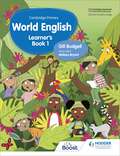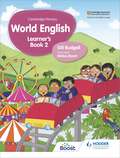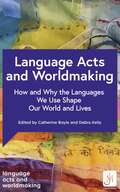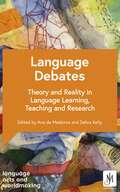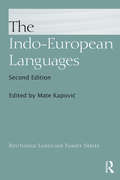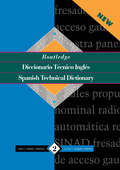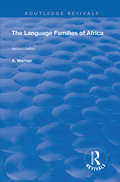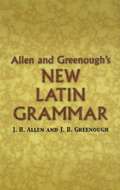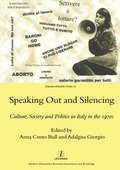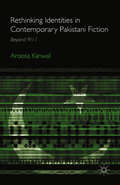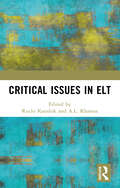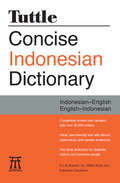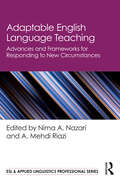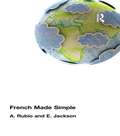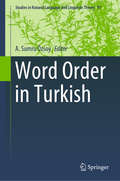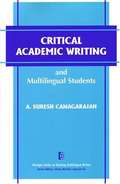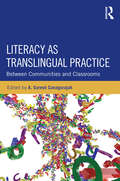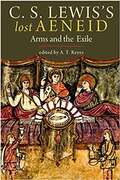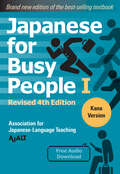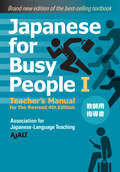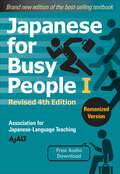- Table View
- List View
Cambridge Primary World English Learner's Book Stage 4 (Hodder Cambridge Primary English as a Second Language)
by Gill BudgellThis title has been endorsed by Cambridge Assessment International Education Engage and inspire learners with an international and interconnected approach developed by experienced teachers and language specialists. The series offers full coverage of the learning objectives for the Cambridge Primary English as a Second language curriculum framework (0057) and is mapped to the Common European Framework of Reference. - Stimulate learners with model texts and activities. - Clearly address the key objectives: reading, writing, speaking, listening and use of English.- Support activities and knowledge covered in the Learner's Book with the accompanying Workbook and Teacher's Guide with Boost subscription.- Audio files are available free at https://www.hoddereducation.co.uk/cambridgeextras
Cambridge Primary World English Learner's Book Stage 2 (Hodder Cambridge Primary English as a Second Language)
by Gill BudgellThis title has been endorsed by Cambridge Assessment International EducationEngage and inspire learners with an international and interconnected approach developed by experienced teachers and language specialists. The series offers full coverage of the learning objectives for the Cambridge Primary English as a Second language curriculum framework (0057) and is mapped to the Common European Framework of Reference.- Stimulate learners with model texts and activities.- Clearly address the key objectives: reading, writing, speaking, listening and use of English.- Support activities and knowledge covered in the Learner's Book with the accompanying Workbook and Teacher's Guide with Boost subscription.- Audio files are available free at https://www.hoddereducation.co.uk/cambridgeextras
Cambridge Primary World English Learner's Book Stage 5 (Hodder Cambridge Primary English as a Second Language)
by Gill BudgellThis title has been endorsed by Cambridge Assessment International Education Engage and inspire learners with an international and interconnected approach developed by experienced teachers and language specialists. The series offers full coverage of the learning objectives for the Cambridge Primary English as a Second language curriculum framework (0057) and is mapped to the Common European Framework of Reference. - Stimulate learners with model texts and activities. - Clearly address the key objectives: reading, writing, speaking, listening and use of English.- Support activities and knowledge covered in the Learner's Book with the accompanying Workbook and Teacher's Guide with Boost subscription.- Audio files are available free at https://www.hoddereducation.co.uk/cambridgeextras
Language Acts and Worldmaking: How and Why the Languages We Use Shape Our World and Our Lives
byCollectively authored by the Language Acts and Worldmaking team, this defining volume offers reflective narratives on research, theory and practice over the course of the flagship project of the same name, funded by the Arts and Humanities Research Council's Open World Research Initiative. It returns to the project's key principles - that our words make worlds and we are agents in worldmaking - analyses the practices and outcomes of collaborative working, and looks to the future by offering concrete ideas for how the work they have done can now continue to do its work in the world.Focusing on the key research strands, this volume looks at the role of the language teacher as a mediator between languages and cultures, worldmaking in modern languages, translation and the imagination, languages and hospitality, digital mediations, and how words change and make worlds. Critically, it analyses the impact on communities of living in multilingual cities, and the ways in which learning a first language, and then a second, and so on, plays a crucial role in our ability to understand our culture in relation to others and to appreciate the ways in which they are intertwined.Specific aims are to: · propose new ways of bridging the gaps between those who teach and research languages and those who learn and use them in everyday contexts from the professional to the personal · put research into the hands of wider audiences · share a philosophy, policy and practice of language teaching and learning which turns research into action · provide the research, experience and data to enable informed debates on current issues and attitudes in language learning, teaching and research · share knowledge across and within all levels and experiences of language learning and teaching · showcase exciting new work that derives from different types of community activity and is of practical relevance to its audiences · disseminate new research in languages that engages with diverse communities of language practitioners.
Language Acts and Worldmaking: How and Why the Languages We Use Shape Our World and Our Lives
byCollectively authored by the Language Acts and Worldmaking team, this defining volume offers reflective narratives on research, theory and practice over the course of the flagship project of the same name, funded by the Arts and Humanities Research Council's Open World Research Initiative. It returns to the project's key principles - that our words make worlds and we are agents in worldmaking - analyses the practices and outcomes of collaborative working, and looks to the future by offering concrete ideas for how the work they have done can now continue to do its work in the world.Focusing on the key research strands, this volume looks at the role of the language teacher as a mediator between languages and cultures, worldmaking in modern languages, translation and the imagination, languages and hospitality, digital mediations, and how words change and make worlds. Critically, it analyses the impact on communities of living in multilingual cities, and the ways in which learning a first language, and then a second, and so on, plays a crucial role in our ability to understand our culture in relation to others and to appreciate the ways in which they are intertwined.Specific aims are to: · propose new ways of bridging the gaps between those who teach and research languages and those who learn and use them in everyday contexts from the professional to the personal · put research into the hands of wider audiences · share a philosophy, policy and practice of language teaching and learning which turns research into action · provide the research, experience and data to enable informed debates on current issues and attitudes in language learning, teaching and research · share knowledge across and within all levels and experiences of language learning and teaching · showcase exciting new work that derives from different types of community activity and is of practical relevance to its audiences · disseminate new research in languages that engages with diverse communities of language practitioners.
Language Debates: Theory and Reality in Language Learning, Teaching and Research (Language Acts and Worldmaking #1)
by VariousThis book captures an urgent moment for language teaching, learning and research. At its core are a series of debates concerning gender stereotyping, the place of linguistics in modern languages, language activism, multilingualism and modern languages and digital humanities. Taken together, these debates explore the work that languages, and that those who learn and speak them, do in the world as well as the way we think 'through' and 'in' a language and are shaped by it. Language Debates acknowledges the history of language teaching and the current realities of language teaching and learning. It is bold in suggesting ways forward for reform and for policy, setting languages and language learning at the heart of a consciously transformative set of goals. This book is therefore essential reading for academics, language teachers, policy makers, students, activists and those passionate about progressing language learning and teaching. The editors and contributors make up a multilingual and multicultural team who work across languages, cultures and borders with a globally-informed approach to their work. Uniquely, the debates in this volume are based on events with participants in the Language Acts and Worldmaking Debates Series and/or workshops within the wider research project and take into account the ensuing discussions there. Each debate is accompanied by an interview which serves as a model on how to continue the conversation beyond the printed pages of the book. You can also discover ways to join the debate through links on the Language Acts and Worldmaking series website (www.jmlanguages.com/languageacts) which includes recorded debates, additional materials and more information about the series. Like all the volumes in the Language Acts and Worldmaking series, the overall aim is two-fold: to challenge widely-held views about language learning as a neutral instrument of globalisation and to innovate and transform language research, teaching and learning, together with Modern Languages as an academic discipline, by foregrounding its unique form of cognition and critical engagement. Specific aims are to:· propose new ways of bridging the gaps between those who teach and research languages and those who learn and use them in everyday contexts from the professional to the personal· put research into the hands of wider audiences · share a philosophy, policy and practice of language teaching and learning which turns research into action· provide the research, experience and data to enable informed debates on current issues and attitudes in language learning, teaching and research· share knowledge across and within all levels and experiences of language learning and teaching· showcase exciting new work that derives from different types of community activity and is of practical relevance to its audiences · disseminate new research in languages that engages with diverse communities of language practitioners.
Language Debates: Theory and Reality in Language Learning, Teaching and Research (Language Acts and Worldmaking #1)
by VariousThis book captures an urgent moment for language teaching, learning and research. At its core are a series of debates concerning gender stereotyping, the place of linguistics in modern languages, language activism, multilingualism and modern languages and digital humanities. Taken together, these debates explore the work that languages, and that those who learn and speak them, do in the world as well as the way we think 'through' and 'in' a language and are shaped by it. Language Debates acknowledges the history of language teaching and the current realities of language teaching and learning. It is bold in suggesting ways forward for reform and for policy, setting languages and language learning at the heart of a consciously transformative set of goals. This book is therefore essential reading for academics, language teachers, policy makers, students, activists and those passionate about progressing language learning and teaching. The editors and contributors make up a multilingual and multicultural team who work across languages, cultures and borders with a globally-informed approach to their work. Uniquely, the debates in this volume are based on events with participants in the Language Acts and Worldmaking Debates Series and/or workshops within the wider research project and take into account the ensuing discussions there. Each debate is accompanied by an interview which serves as a model on how to continue the conversation beyond the printed pages of the book. You can also discover ways to join the debate through links on the Language Acts and Worldmaking series website (www.jmlanguages.com/languageacts) which includes recorded debates, additional materials and more information about the series. Like all the volumes in the Language Acts and Worldmaking series, the overall aim is two-fold: to challenge widely-held views about language learning as a neutral instrument of globalisation and to innovate and transform language research, teaching and learning, together with Modern Languages as an academic discipline, by foregrounding its unique form of cognition and critical engagement. Specific aims are to:· propose new ways of bridging the gaps between those who teach and research languages and those who learn and use them in everyday contexts from the professional to the personal· put research into the hands of wider audiences · share a philosophy, policy and practice of language teaching and learning which turns research into action· provide the research, experience and data to enable informed debates on current issues and attitudes in language learning, teaching and research· share knowledge across and within all levels and experiences of language learning and teaching· showcase exciting new work that derives from different types of community activity and is of practical relevance to its audiences · disseminate new research in languages that engages with diverse communities of language practitioners.
The Indo-European Languages
by Anna Giacalone Ramat Paolo Ramat Mate Kapovi 263The Indo-European Languages presents a comprehensive survey of the individual languages and language subgroups within this language family. With over four hundred languages and dialects and almost three billion native speakers, the Indo-European language family is the largest of the recognized language groups and includes most of the major current languages of Europe, the Iranian plateau and the Indian subcontinent. Written by an international team of experts, this comprehensive, single-volume tome presents in-depth discussions of the historical development and specialized linguistic features of the Indo-European languages. This unique resource remains the ideal reference for advanced undergraduate and postgraduate students of Indo-European linguistics and languages, but also for more experienced researchers looking for an up-to-date survey of separate Indo-European branches. It will be of interest to researchers and anyone with an interest in historical linguistics, linguistic anthropology and language development.
Routledge Spanish Technical Dictionary Diccionario tecnico inges: Volume 2: English-Spanish/ingles-Espanol (Routledge Bilingual Specialist Dictionaries)
by 0 Routledge,These 2 volumes consist of some 100,000 headwords in both Spanish and English, including 3,000 abbreviations. Terms are drawn from the whole range of modern applied science and technical terminology. These volumes can be purchased either separately or together in print. Each volume is compiled by an international team of subject terminologists, native English and Spanish speakers. Special attention is given to differences between UK and US terminology, and to Spanish and Latin-American variants. Over 70 subject areas are covered. Estos 2 volúmenes constan de unos 100.000 lemas tanto en español como en inglés, incluidas 3.000 abreviaturas. Los términos se extraen de toda la gama de terminología técnica y científica aplicada moderna. Estos volúmenes se pueden comprar por separado o juntos en forma impresa. Cada volumen es compilado por un equipo internacional de terminólogos temáticos, hablantes nativos de inglés y español. Se presta especial atención a las diferencias entre la terminología del Reino Unido y Estados Unidos, y a las variantes española y latinoamericana. Se cubren más de 70 áreas temáticas.
The Language Families Of Africa: Second edition (Routledge Revivals)
by A WernerPublished in 1925, this introduction provides an accessible account of language families in Africa. Covering the five families of African languages: the Sudan family, the Bantu family, the Hamitic family, the Bushman family and the Semitic family, it provides a detailed study of the languages, phonetics and linguistic content. The book will be of use to anyone interested in the history and development of human speech.
Allen and Greenough's New Latin Grammar
by James B Greenough G. L. Kittredge Benj. L. D'Ooge A. A. Howard J. H. AllenA venerable resource for more than a century, Allen and Greenough's New Latin Grammar is still regarded by students and teachers as the finest Latin reference grammar available. Concise, comprehensive, and well organized, it is unrivaled in depth and clarity, placing a wealth of advice on usage, vocabulary, diction, composition, and syntax within easy reach of Latin scholars at all levels. This sourcebook's three-part treatment starts with words and forms, covering parts of speech, declensions, and conjugations. The second part, syntax, explores cases, moods, and tenses. The concluding section offers information on archaic usages, Latin verse, and prose composition, among other subjects. Extensive appendixes feature a glossary of terms and indexes. Students of history, religion, and literature will find lasting value in this modestly priced edition of a classic guide to Latin.
Speaking Out and Silencing: Culture, Society and Politics in Italy in the 1970s
by A. BullCommonly referred to collectively as the anni di piombo -- years of lead -- the 1970s have been seen as a parenthesis in Italian history, which was dominated by political violence and terrorism. The seventeen essays in this wide-ranging collection adopt different scholarly perspectives to challenge this monolithic view and uncover the complexity of the decade, exploring its many facets and re-assessing political conflict. The volume brings to the fore the ruptures of the period through an examination of literature, film, gender relations, party politics and political participation, social structures and identities. This more balanced assessment of the period allows the vibrancy and dynamism of new social and cultural movements to emerge. The long-lasting effects of this period on Italian culture and society and its crucial legacy to the present are lucidly revealed, dispelling the widely-held belief that the 1970s were largely a regressive decade. With the contributions: Anna Cento Bull, Adalgisa Giorgio -- The 1970s through the Looking GlassPiero Ignazi -- Italy in the 1970s between Self-Expression and OrganicismPaola Di Cori -- Listening and Silencing. Italian Feminists in the 1970s: Between autocoscienza and TerrorismAmalia Signorelli -- Women in Italy in the 1970sLesley Caldwell -- Is the Political Personal? Fathers and Sons in Bertolucci's Tragedia di un uomo ridicolo and Amelio's Colpire al cuoreJennifer Burns -- A Leaden Silence? Writers' Responses to the anni di piomboAdalgisa Giorgio -- From Little Girls to Bad Girls: Women's Writing and Experimentalism in the 1970s and 1990sEnrico Palandri -- The Difficulty of a Historical Perspective on the 1970sMark Donovan -- The Radicals: An Ambiguous Contribution to Political InnovationCarl Levy -- Intellectual Unemployment and Political Radicalism in Italy, 1968-1982Roberto Bartali -- The Red Brigades and the Moro Kidnapping: Secrets and LiesTom Behan -- Allende, Berlinguer, Pinochet... and Dario FoPhilip Cooke -- 'A riconquistare la rossa primavera' The Neo-Resistance of the 1970sClaudia Bernardi -- Collective Memory and Childhood Narratives: Rewriting the 1970s in the 1990sValeria Pizzini Gambetta -- Becoming Visible: Did the Emancipation of Women Reach the Sicilian Mafia?Davide PerO -- The Left and the Construction of Immigrants in 1970s ItalyAnna Cento Bull -- From the Centrality of the Working Class to its Demise: The Case of Bagnoli, Naples
Rethinking Identities in Contemporary Pakistani Fiction: Beyond 9/11
by A. KanwalThis book focuses on the way that notions of home and identity have changed for Muslims as a result of international 'war on terror' rhetoric. It uniquely links the post-9/11 stereotyping of Muslims and Islam in the West to the roots of current jihadism and the resurgence of ethnocentrism within the subcontinent and beyond.
Critical Issues in ELT
by Ruchi Kaushik A. L. KhannaELT, a vast and growing field of research, has now moved beyond primary concerns related to developing learners’ proficiency in the language and designing curricula, syllabi, materials and assessment tools. It is witnessing rapid development towards de-centralizing and de-elitizing English, promoting multilingual approaches for teaching English and bridging the gap between language-in-education policies and practices.Critical Issues in ELT compiles research papers by linguists, language teachers, and English language teaching professionals to present contemporary debates on critical issues related to English language teaching, primarily in India. The subject matter of this book includes a variety of articles based on empirical data. It discusses the challenges facing ELT today and also includes papers discussing theoretical positions/frameworks/issues in ELT, classroom-based action research projects, and personal narratives.Print edition not for sale in South Asia (India, Sri Lanka, Nepal, Bangladesh, Pakistan or Bhutan)
Tuttle Concise Indonesian Dictionary: Indonesian-English English-Indonesian
by Katherine Davidsen Willie Koen A. L. N. Kramer Sr.This is the most up-to-date Indonesian Dictionary on the marketTuttle Concise Indonesian Dictionary has both Indonesian to English and English to Indonesian sections. It's compact size allows for easy transport without limiting the content.<P><P> This Indonesian dictionary is perfect for Indonesian language students, or business people and tourists traveling to Indonesia. It contains over 20,000 words and expressions, carefully selected to cover all important aspects of life and commerce in Indonesia. In addition, extensive information on Indonesian grammar and Indonesian pronunciation are included.Concise Indonesian Dictionary contains the following features:25,000 Indonesian words and expressionsUp-to-date local Indonesian slang and idiomsA guide to Indonesian pronunciation and Indonesian GrammarEnglish and Indonesian ScriptExtensive notes with detailed tips on usage and social contextParts of speech, common phrases and idiomatic expressionsOther dictionaries in this bestselling series you might be interested in include: Concise Tagalog Dictionary, Concise Vietnamese Dictionary, and Concise Balinese Dictionary.
Adaptable English Language Teaching: Advances and Frameworks for Responding to New Circumstances (ISSN)
by A. Mehdi Riazi Nima A. NazariIn an age of rapid technological transformation and evolving teaching settings, the ELT community must adapt to the needs of emerging situations and a diverse range of learners. Adaptable English Language Teaching addresses this need by bringing together contributions from renowned scholars around the world with insights on all major areas of English language teaching with an emphasis on adaptability—of teaching method, context, skills, and priorities.Organized around an innovative past-present-future structure, chapters offer methods, strategies, and perspectives that are adaptable to any difficult or under-resourced context. It delves into engaging through online applications, understanding emerging trends in computer-assisted language learning and teaching, and the implementation of virtual classroom and multimodality in ELT.Given its multifaceted focus, this book will provide ELT practitioners, trainers, trainees, and researchers with invaluable insights and research findings to effectively navigate and adapt to emerging circumstances.
Thamiz Inru
by A. RavisankarThis book is a collection of articles written by the Author in his Blog from 2005 to 2013 about the state of Tamil language and how to write and read Tamil in computers and smart phones.
French Made Simple
by E. Jackson A. RubioThis is as complete beginner's course in French which covers the requirements of the various GCSE examination syllabuses, and provides a good background to the language for students on RSA and other similar courses. The approach is designed to be of particular value for further education and self-study purposes.
Word Order in Turkish (Studies in Natural Language and Linguistic Theory #97)
by A. Sumru ÖzsoyThis volume is a collection of studies on various aspects of word order variation in Turkish. As a head-final, left-branching ‘free’ word order language, Turkish raises a number of significant theory-internal as well as language-particular questions regarding linearization in language. Each of the contributions in the present volume offers a fresh insight into a number of these questions, thus, while expanding our knowledge of the language-particular properties of the word order phenomena, also contribute individually to the theory of linearization in general. Turkish is a configurational language. It licenses constructions in which constituents can occur in non-canonical presubject as well as postverbal positions. Presented within the assumptions of the generative tradition, the discussion and analyses of the various aspects of the linearization facts of the language offer a novel treatment of the issues therein. The authors approach the word order phenomena from a variety of perspectives, ranging from purely syntactic treatments, to accounts as syntax-PF interface or syntax-discourse interface phenomena or as output of base generation.
Critical Academic Writing and Multilingual Students
by Canagarajah A. SureshThe critical approach to L2 writing is arguably one of the most significant recent developments in L2 writing pedagogy. A. Suresh Canagarajah provides a thorough discussion of this topic in Critical Academic Writing and Multilingual Students. This volume facilitates teacher self-reflection and enables readers to better understand the motivations and pedagogical implications--especially for L2 writing--of a more openly pedagogical approach. Critical Academic Writing and Multilingual Students explains what it means to commit to an academic pedagogy, in terms of form, self, content, and community--and what it can accomplish in the L2 writing classroom. It's a guide for writing teachers who wish to embark on a journey toward increased critical awareness of the role they play, or potentially could play, in the lives of their students.
Literacy as Translingual Practice: Between Communities and Classrooms
by A. Suresh CanagarajahThe term translingual highlights the reality that people always shuttle across languages, communicate in hybrid languages and, thus, enjoy multilingual competence. In the context of migration, transnational economic and cultural relations, digital communication, and globalism, increasing contact is taking place between languages and communities. In these contact zones new genres of writing and new textual conventions are emerging that go beyond traditional dichotomies that treat languages as separated from each other, and texts and writers as determined by one language or the other. Pushing forward a translingual orientation to writing—one that is in tune with the new literacies and communicative practices flowing into writing classrooms and demanding new pedagogies and policies— this volume is structured around five concerns: refining the theoretical premises, learning from community practices, debating the role of code meshed products, identifying new research directions, and developing sound pedagogical applications. These themes are explored by leading scholars from L1 and L2 composition, rhetoric and applied linguistics, education theory and classroom practice, and diverse ethnic rhetorics. Timely and much needed, Literacy as Translingual Practice is essential reading for students, researchers, and practitioners across these fields.
C. S. Lewis's Lost Aeneid: Arms and the Exile
by C. S. Lewis A. T. ReyesC. S. Lewis (1898–1963) is best remembered as a literary critic, essayist, theologian, and novelist, and his famed tales The Chronicles of Narnia and The Screwtape Letters have been read by millions. Now, A. T. Reyes reveals a different side of this diverse man of letters: translator. <p><p> Reyes introduces the surviving fragments of Lewis's translation of Virgil's epic poem, which were rescued from a bonfire. They are presented in parallel with the Latin text, and are accompanied by synopses of missing sections, and an informative glossary, making them accessible to the general reader. Writes Lewis in A Preface to Paradise Lost, “Virgil uses something more subtle than mere length of time…. It is this which gives the reader of the Aeneid the sense of having lived through so much. No man who has read it with full perception remains an adolescent.” Lewis's admiration for the Aeneid, written in the 1st century BC and unfolding the adventures of Aeneas, a Trojan who traveled to Italy and became the ancestor of the Romans, is evident in his remarkably lyrical translation. <p><p> C. S. Lewis's Lost Aeneid is part detective story, as Reyes recounts the dramatic rescue of the fragments and his efforts to collect and organize them, and part illuminating look at a lesser-known and intriguing aspect of Lewis's work.
Japanese for Busy People Book 1: Revised 4th Edition (Japanese for Busy People Series)
by AJALT4th Revised Edition of JAPANESE FOR BUSY PEOPLE, the most popular Japanese language textbook series in the world. Since it was first published in 1984, the focus of the Japanese for Busy People series has always been to teach Japanese for effective communication. As suggested in the title, this is a concise course for busy students who want to learn natural, spoken Japanese as efficiently as possible in a limited amount of time. The new Japanese for Busy People: Revised 4th Edition is made up of three volumes: Book I, Book II, and Book III. Book I is available in both romanized and kana versions, similar to the Revised 3rd Edition. The Kana Version is exactly the same as the Romanized Version except for the scripts used throughout the book: hiragana and katakana. The Kana Version is therefore recommended for those who have already learned kana (as these scripts are collectively called) or are learning them with Japanese for Busy People Kana Workbook or another such text. Studying Japanese in kana, rather than in romanized script, can lead to fluent pronunciation and facilitate a smooth transition to the study of kanji.
Japanese for Busy People Book 1: Revised 4th Edition (Japanese for Busy People Series)
by AJALTJapanese for Busy People is the most popular Japanese language textbook series in the world. Japanese for Busy People series is one of the most comprehensive series containing texts, workbooks and teacher&’s manuals for all three volumes. Audio recordings for the dialogues and listening exercises are now available as free download from kodansha.us. Teacher&’s Manual provides specific suggestions for teachers on how to use the main text in a classroom setting and how to coordinate it with the workbook. CAN-DO section is useful in creating lesson plan and measuring learners&’ mastery level. It also contains a Japanese translation of all of the key components of the main text, such as culture notes, notes on Japanese grammar, and active communication. This first of three volumes introduces "survival Japanese" — the absolute minimum amount of Japanese needed to live in Japan. Thus, the vocabulary and grammatical items it introduces are limited to about a third of what is typically introduced in a first-year course. In addition, the book features notes on Japanese culture intended to expand the learner&’s understanding of Japan, its customs and people. Japanese for Busy People I is available in two formats: romanized and kana. The Romanized Version uses romanized Japanese throughout, with kana in the Opening Dialogues of each lesson. The Kana Version — exposing students to hiragana and katakana from the very beginning — uses only kana.The content of the two books is otherwise exactly the same. The companion volume, Japanese for Busy People 1: The Workbook for the Revised 4th Edition contains a variety of illustrated exercises for mastering the basic sentence patterns presented in the main text.
Japanese for Busy People Book 1: Revised 4th Edition (Japanese for Busy People Series)
by AJALT4th Revised Edition of JAPANESE FOR BUSY PEOPLE, the most popular Japanese language textbook series in the world.Since it was first published in 1984, the focus of the Japanese for Busy People series has always been to teach Japanese for effective communication. As suggested in the title, this is a concise course for busy students who want to learn natural, spoken Japanese as efficiently as possible in a limited amount of time.The new Japanese for Busy People: Revised 4th Edition is made up of three volumes: Book I, Book II, and Book III. Book I is available in both romanized and kana versions, similar to the Revised 3rd Edition.The Romanized Version uses romanized Japanese throughout, with kana in the Target Dialogues of each lesson.
